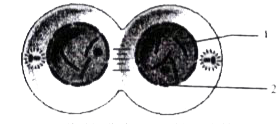In which type of cell division, chromosome number becomes halved in daughter cells?
To answer the question, "In which type of cell division does the chromosome number become halved in daughter cells?", we can follow these steps:
1. Understanding Cell Division Types:
- There are two main types of cell division: mitosis and meiosis. It is essential to know the purpose and outcome of each type.
2. Mitosis Overview:
- Mitosis is a type of cell division that results in two daughter cells, each having the same number of chromosomes as the parent cell. This means that if the parent cell is diploid (2n), the daughter cells will also be diploid (2n).
3. Meiosis Overview:
- Meiosis, on the other hand, is a specialized form of cell division that occurs in the formation of gametes (sperm and egg cells). It consists of two rounds of division (meiosis I and meiosis II).
4. Chromosome Number Reduction in Meiosis:
- During meiosis I, homologous chromosomes are separated, resulting in daughter cells that have half the number of chromosomes compared to the original parent cell. If the parent cell is diploid (2n), the resulting daughter cells will be haploid (n).
5. Conclusion:
- Therefore, the type of cell division in which the chromosome number becomes halved in daughter cells is meiosis.
Final Answer:
The correct answer is meiosis.
---
- There are two main types of cell division: mitosis and meiosis. It is essential to know the purpose and outcome of each type.
- Mitosis is a type of cell division that results in two daughter cells, each having the same number of chromosomes as the parent cell. This means that if the parent cell is diploid (2n), the daughter cells will also be diploid (2n).
- Meiosis, on the other hand, is a specialized form of cell division that occurs in the formation of gametes (sperm and egg cells). It consists of two rounds of division (meiosis I and meiosis II).
- During meiosis I, homologous chromosomes are separated, resulting in daughter cells that have half the number of chromosomes compared to the original parent cell. If the parent cell is diploid (2n), the resulting daughter cells will be haploid (n).
- Therefore, the type of cell division in which the chromosome number becomes halved in daughter cells is meiosis.
The correct answer is meiosis.
Topper's Solved these Questions
- BOOK - ICSECHAPTER - CELL CYCLE AND CELL DIVISION EXERCISE - TEST YOUR PROGRESS (SHORT/LONG ANSWER TYPE QUESTIONS)12videos
CELL CYCLE AND CELL DIVISION
- BOOK - ICSECHAPTER - CELL CYCLE AND CELL DIVISION EXERCISE - TEST YOUR PROGRESS (HIGHER ORDER THINKING SKILLS QUESTIONS (HOTS))8videos
CELL CYCLE AND CELL DIVISION
- BOOK - ICSECHAPTER - CELL CYCLE AND CELL DIVISION EXERCISE - TEST YOUR PROGRESS (State whether the following statements are true)15videos
CELL CYCLE AND CELL DIVISION
- BOOK - ICSECHAPTER - CELL : THE UNIT OF LIFE EXERCISE - Differentiate Between18videos
CELL : THE UNIT OF LIFE
- BOOK - ICSECHAPTER - CELLULAR RESPIRATION IN PLANTS EXERCISE - REVIEW QUESTIONS ( LONG ANSWER TYPE QUESTIONS)15videos
CELLULAR RESPIRATION IN PLANTS
Similar Questions
Knowledge Check
- Question 1 - Select One
The phase of cell division by which the chromosome number is halved is known as:
AmitosisBmeiosis ICmeiosis IIDkaryokinesis - Question 2 - Select One
Identify the figures numbering to a type of cell division showing different stages.

In which stage of cell division chromosome gets attached to spindle by its centromere?AAnaplaseBProphaseCMetaphaseDTelophase - Question 3 - Select One
During cell division, chromosome attaches with spindles at:
AkinetochoreBcentromereCcentrioleDsecopdary constriction
Which type of cell division occurs in the gonads
View SolutionIn which stage of cell division, number of chromosomes best counted:-
View SolutionWhich type of germ cells contain 23 chromosomes
View SolutionStudy the diagram given below which represents a stage during the mitotic cell division and answer the questions that follow:

Which is the cell division that results in half the number of chromosomes in daughter cells?View SolutionChromosome number of the parent is conserved in the daughter cells in
View Solution

